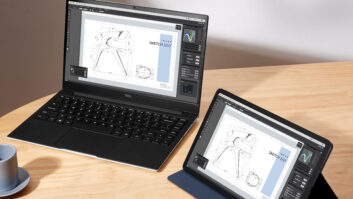New York — Olympus launched its first digital camera based on the Micro Four Thirds standard, entering a market in which only one other company, Panasonic, is a player.
The retro-style EP-1 PEN camera, with 12.3-megapixel resolution and 3-inch live-view LCD viewing screen, will be the smallest Micro Four Thirds model on the market when it becomes available in stores in July, the company said. At 4.75 inches by 2.75 inches by 1.43 inches, it’s about 30 percent smaller than Panasonic’s smallest model, product manager Sally Smith Clemens told TWICE.
The Micro Four Thirds standard dispenses with a d-SLR’s mirror-and-prism configuration to reduce the
distance between lens and 4:3 imaging sensor by about 50 percent and to eliminate the prism mechanism that adds a d-SLR’s distinguishing prism “hump” on top of the camera body. The standard is promoted as packing a d-SLR’s picture quality and interchangeable-lens capability into a smaller package that will encourage point-and-shoot owners to step up. Many point-and-shoot customers aren’t thrilled with the bulk of a d-SLR, and many are intimidated by all the buttons, Clemens said.
The camera will also appeal to photo enthusiasts who want full manual control and interchangeable lenses, although the camera offers a full-automatic option, Clemens said. The camera will also appeal to tech aficionados who want the latest technology, she added.
The estimated everyday price of the E-P1’s body is $749. At $799, the E-P1 body is packaged with an ED 14-42mm f3.5/5.6 Zuiko digital zoom lens, and the body with ED 17mm f2.8 with companion optical viewfinder is $899. An optional flash is $199, but a $100 rebate through September brings the price to $99.
Panasonic’s models are priced at $799 and $1,499.
The PEN’s body, compatible with Olympus film-camera lenses dating back to the 1970s, is made from stainless steel and aluminum. It’s available in silver or white.
Also to differentiate its product, Olympus said the PEN is the only Micro Four Thirds camera with stainless-
steel body, stereo CD-quality 16-bit, 44.1kHz PCM recording, 30fps HD video recording, and selectable built-in melodies for slideshow and movie playback. It also features a digital voice recorder, dust-reduction system, art filters to customize pictures and videos, multiple exposures, and HDMI output.
For HD video, the camera supports 1,720 by 1,280 resolution with progressive scanning and 30fps frame rate. Olympus called the latter two specs more important than full 1,920 1,080 HD resolution. The camera records video in AVI format rather than AVCHD for compatibility with more PCs.
Another differentiating feature is mechanical image stabilization built into the camera’s body, enabling the feature to be used with multiple lenses, including older film-camera lenses, compared to electronic image stabilization built directly into lenses.
Shutter lag is 70ms, which the company called average for d-SLRs. The company’s top-end d-SLR features a lag of about 53ms.
Compared the entry-level d-SLR’s starting at about $499, the PEN at a higher price adds improved resolution, HD video, smaller form factor, and better noise and color processing, a spokesperson noted.
To reduce size compared to Panasonic models, Olympus dispensed with an integrated hand grip and eliminated a top-mount digital viewfinder that would complement the back-chassis LCD screen.
The E-P1’s design mimics the original Olympus PEN, which was introduced in 1959.
“The E-P1 is designed for the mobile, visual generation that lives active lives online and off, and its portability ensures that it will go with you wherever life takes you,” said John Knaur, senior marketing manager for digital SLRs.
“The E-P1 truly allows you to capture it all with the highest still-photo image quality blended with HD video, high-end audio, multiple exposure and creative art filters in one small, stylish camera,” he added.
The E-P1 comes with USB cable, video cable, lithium-ion battery pack (BLS-1), lithium-on battery charger (BCS-1), shoulder strap, Olympus Master 2 software CD-ROM, manuals and registration card.













